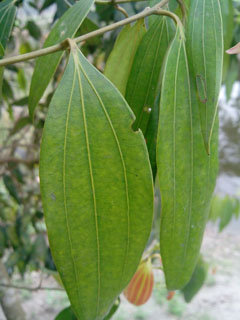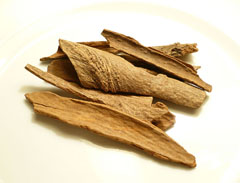 |
|
Badagnani wikimedia.org |
 |
| Kayser Ahmad wikimedia.org |
Translate this page:
Summary
Saigon Cinnamon (Cinnamomum lourieroi), otherwise known as Vietnamese cinnamon and Vietnamese cassia, is an evergreen tree indigenous to Southeast Asia that has the highest amount of coumarin content among other species under the Cinnamomum genus. The bark and the essential oil obtained from it are both used as food flavouring. The bark, usually harvested from young branches is further used for baking and made into cordial. Unripe fruits are dried and sold as cassia buds for food flavourings. Medicinally, the dried bark is often used in association with other medicines as it is an astringent, carminative, stimulant, and stomachic.
Physical Characteristics

 Cinnamomum loureiroi is an evergreen Tree growing to 18 m (59ft) by 15 m (49ft) at a medium rate.
Cinnamomum loureiroi is an evergreen Tree growing to 18 m (59ft) by 15 m (49ft) at a medium rate.
See above for USDA hardiness. It is hardy to UK zone 10.
Suitable for: light (sandy), medium (loamy) and heavy (clay) soils and prefers well-drained soil. Suitable pH: mildly acid, neutral and basic (mildly alkaline) soils and can grow in very acid and very alkaline soils.
It can grow in semi-shade (light woodland) or no shade. It prefers moist soil.
UK Hardiness Map
US Hardiness Map
Synonyms
No synonyms are recorded for this name.
Plant Habitats
Edible Uses
Edible Parts: Flowers Fruit Inner bark Oil
Edible Uses: Drink Oil
Edible portion: Bark, Spice, Flower Buds. The bark, and an essential oil obtained from it, are much used as a flavouring in a wide range of foods[ 301 ]. Highly esteemed in China and Japan, and considered by many to be superior to the more widely used cinnamon (C. verum)[ 301 ]. The bark is sweeter than cinnamon and is used for baking and is made into a cordial[ 238 ]. The bark is usually harvested from young branches[ 418 ]. The bark is peeled from the stems and branches and set aside to dry. Some varieties are scraped. While drying, the bark curls into quills. The colour varies from light reddish brown for the thin, scraped bark to grey for the thick, unscraped bark[ 418 ]. The unripe fruits are dried and sold as cassia buds, for use as food flavourings[ 301 ]. They have a cinnamon-like aroma and a warm, sweet, pungent taste akin to that of cassia bark[ 418 ].
References More on Edible Uses
Medicinal Uses
Plants For A Future can not take any responsibility for any adverse effects from the use of plants. Always seek advice from a professional before using a plant medicinally.
Aromatic Astringent Carminative Stimulant Stomachic
The dried bark is aromatic, astringent, carminative, stimulant and stomachic[ 46 , 785 ]. It is often used in association with other medicines[ 785 ]. The bark contains around 2.5% essential oil, which is particularly rich in cinnamic acid[ 785 ]. Saigon cinnamon has 1-5% essential oil in content and 25% cinnamaldehyde in essential oil, which is the highest of all the cinnamon species.
References More on Medicinal Uses
The Bookshop: Edible Plant Books
Our Latest books on Perennial Plants For Food Forests and Permaculture Gardens in paperback or digital formats.

Edible Tropical Plants
Food Forest Plants for Hotter Conditions: 250+ Plants For Tropical Food Forests & Permaculture Gardens.
More

Edible Temperate Plants
Plants for Your Food Forest: 500 Plants for Temperate Food Forests & Permaculture Gardens.
More

More Books
PFAF have eight books available in paperback and digital formats. Browse the shop for more information.
Shop Now
Other Uses
Essential Oil
Other uses rating: Low (2/5). The bark contains 1 to 7% of essential oil[ 418 ].
Special Uses
Food Forest
References More on Other Uses
Cultivation details
A plant of moist lowland areas in the tropics and subtropics, where it is found at elevations up to 1,000 metres[ 418 ]. It grows best in areas where the mean annual temperature is 20 - 30°c, but tolerates 17 - 34°c[ 418 ]. It prefers a mean annual rainfall of 2,500 - 3,000mm, tolerating 1,500 - 3,500mm[ 418 ]. It grows in areas with all year rainfall and also with a distinct dry season[ 418 ]. Prefers a fertile, sandy, moisture-retentive but freely draining soil in full sun or partial shade[ 200 ]. Prefers a pH in the range 5 - 6.4, tolerating 4.5 - 8[ 418 ]. Harvest of superior bark cannot usually take place until the trees are at least 10 - 12 years old[ 418 ].
References Carbon Farming Information and Carbon Sequestration Information
Temperature Converter
Type a value in the Celsius field to convert the value to Fahrenheit:
Fahrenheit:
The PFAF Bookshop
Plants For A Future have a number of books available in paperback and digital form. Book titles include Edible Plants, Edible Perennials, Edible Trees,Edible Shrubs, Woodland Gardening, and Temperate Food Forest Plants. Our new book is Food Forest Plants For Hotter Conditions (Tropical and Sub-Tropical).
Shop Now
Plant Propagation
Seed - the seed has a short viability and is best sown as soon as it is ripe in a greenhouse[ 200 ]. Remove the fruit pulp since this can inhibit germination[ 200 ]. Germination can take 1 - 6 months at 20°c[ 164 ]. Stored seed should be sown as soon as possible in containers[ 78 ]. When they are large enough to handle, prick the seedlings out into individual pots and plant them out into their permanent positions when 10cm or more tall. Cuttings of semi-ripe side shoots, 7cm with a heel, June/July in a frame with bottom heat[ 78 ].
Other Names
If available other names are mentioned here
Saigon Cinnamon (Cinnamomum lourieroi), otherwise known as Vietnamese cinnamon and Vietnamese cassia. Also known as: Vietnamese cassia, Baker's cinnamon, Vietnamese cinnamon and qu_ trˆ my, qu_ thanh, or " qu_ trˆ b_ng" in Vietnam. Nikkei, Nhucque, Que thanh, Saigon cassia, Saigon cinnamon, Yukgyenamu.
Native Range
TROPICAL ASIA: Vietnam
Weed Potential
Right plant wrong place. We are currently updating this section.
Please note that a plant may be invasive in one area but may not in your area so it's worth checking.
None Known
Conservation Status
IUCN Red List of Threatened Plants Status : This taxon has not yet been assessed

Growth: S = slow M = medium F = fast. Soil: L = light (sandy) M = medium H = heavy (clay). pH: A = acid N = neutral B = basic (alkaline). Shade: F = full shade S = semi-shade N = no shade. Moisture: D = dry M = Moist We = wet Wa = water.
Now available:
Food Forest Plants for Mediterranean Conditions
350+ Perennial Plants For Mediterranean and Drier Food Forests and Permaculture Gardens.
[Paperback and eBook]
This is the third in Plants For A Future's series of plant guides for food forests tailored to
specific climate zones. Following volumes on temperate and tropical ecosystems, this book focuses
on species suited to Mediterranean conditions—regions with hot, dry summers and cool, wet winters,
often facing the added challenge of climate change.
Read More
Expert comment
Author
Nees
Botanical References
Links / References
For a list of references used on this page please go here
A special thanks to Ken Fern for some of the information used on this page.
Readers comment
| Add a comment |
|
If you have important information about this plant that may help other users please add a comment or link below. Only comments or links that are felt to be directly relevant to a plant will be included. If you think a comment/link or information contained on this page is inaccurate or misleading we would welcome your feedback at [email protected]. If you have questions about a plant please use the Forum on this website as we do not have the resources to answer questions ourselves.
* Please note: the comments by website users are not necessarily those held by PFAF and may give misleading or inaccurate information.
To leave a comment please Register or login here All comments need to be approved so will not appear immediately.
|
Subject : Cinnamomum loureiroi
|
|
|
|